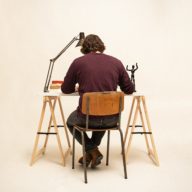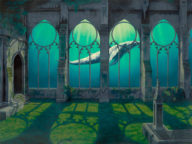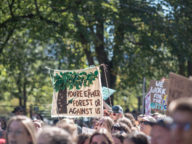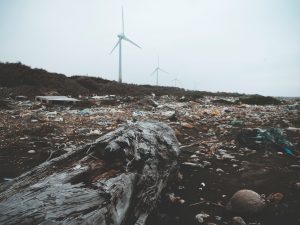[Editor’s Note: When God created the world, he saw that “it was good.” In this series, we want to explore how our faith in Jesus helps us celebrate and enjoy what’s good in creation––but also work as stewards to help it thrive to its fullest potential. Caring for our planet, including plants and animals, fungi and microbes, ecosystems and people, is a high calling from God––a calling in which we can engage out of love and not fear. The gospel gives us hope that what is broken can be restored, and even now, we can enjoy what has been given to us. Join us as we #celebratecreation.]
This is an excerpt from artist Josh Tiessen’s new book, Streams in the Wasteland.
Josh Tiessen was born in 1995 in Moscow, Russia. He is an international award-winning contemporary artist, who works from Josh Tiessen Studio Gallery, located between Toronto and Niagara Falls, Ontario. His shaped oil paintings, which take 200-1700 hours to complete, reflect the interaction between the natural world and human cultures. Mentored by acclaimed Canadian wildlife artist Robert Bateman, Tiessen has exhibited his work since 2006 in over 100 shows including the National Gallery of Canada and prestigious galleries throughout the United States. Tiessen is often featured in the press and media, and is a sought-after speaker, teacher and writer, graduating with a Bachelor of Religious Education in Arts, Biblical Studies, and Philosophy in 2020.
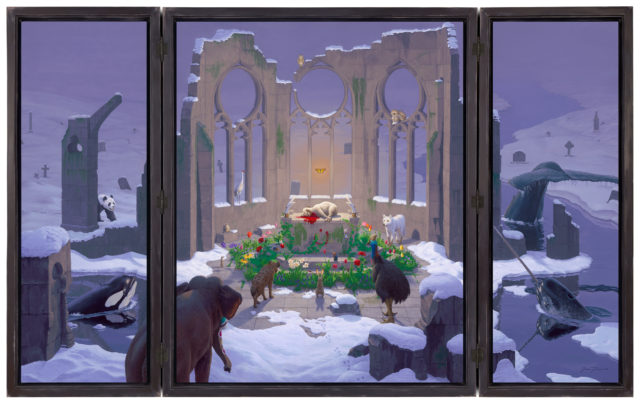
Agnus Dei
Oil on Birch, 65 x 105 x 3 inches, 2020-21
For the better part of 2020 I toiled away on this monumental work, which I called my pandemic painting. Lockdowns afforded me the social acceptability of living a hermit’s lifestyle in my studio, spending over 1700 hours on this altarpiece triptych (3 panels). In order to achieve an epic finale to my Streams in the Wasteland series, I called back for an encore the characters from all of the other paintings — seventeen representative animals.
This painting is a musing on the moral innocence of animals, something we as humans cannot claim for ourselves. In the biblical book of Isaiah, chapter 53, we read a prophecy about a Suffering Servant likened to an innocent lamb:
He was oppressed and afflicted,
yet he did not open his mouth;
he was led like a lamb to the slaughter,
and as a sheep before its shearers is silent,
so he did not open his mouth.
(Isaiah 53:7)
Throughout history this prophecy is believed by Messianic Jews and Christians to be fulfilled in Jesus of Nazareth. He lived a perfectly moral, sinless life, but suffered the injustice of a criminal’s death on a Roman cross, according to multiple eyewitness accounts in the New Testament written by his closest apprentices. As I pondered this, I came to the realization that all animals share in this mystical union of purity with Christ. Yet they have unfairly carried the burden of humanity’s sins — through wars, greed, and exploitation. Over the millennia we have demanded and relied on animals sacrificing their labour, and often their very lives, for our own survival.
I drew influence from historical paintings that have depicted the symbol of Agnus Dei (Lamb of God), such as Jan van Eyck’s Adoration of the Lamb (1432) and Francisco de Zurbarán’s Agnus Dei (1635-40). However, my painting is also a critique of the human-centric bias in Christian art history. This is best exemplified in Renaissance paintings where animals seldom appear, and if they do it is simply for allegorical purposes. By enlisting wild animals as protagonists with intrinsic value amidst the wasteland of human existence, I purposed to revise western art history by employing a zoological lens. This liberates the Judeo-Christian worldview from its perversion at the hands of anthropocentric Greek philosophy. I sought to depict a visual theology of how animals are paragons of moral innocence. A recurring theme throughout Isaiah is how animals are faithful to their Creator in contrast to humans who are not (Isaiah 43:20). When confronted with the Lamb of God, the prophet states that “each of us has turned to our own way” (Isaiah 53:6).
In the Jewish sacrificial system the altar was adorned with rams’ horns, which I believe symbolized the countless animal deaths required to pay for the people’s wrongdoing. For my altar depiction I have instead employed elephant tusks, representing modern-day animal sacrifice such as the illegal ivory trade. Likewise, the bloody slain lamb alludes to the cruel practice of vivisection (animal testing) and cloning for biomedical experimentation (The first mammal to be cloned was a sheep named Dolly in 1996).
The gravestones in my painting honour species that have gone extinct throughout the ages. According to scientists, in order to have rich biodeposits (raw materials) to sustain complex human civilization, it was necessary for millions of species like the Pikaia, Quetzalcoatlus, and Sabretooth Tiger to lay down their lives for us to exist (Hugh Ross, More Than A Theory. 83-85, 193). Species like the Dodo Bird went extinct due to habitat destruction by humans. Sadly, today we are witnessing the sixth mass-extinction called the “Anthropocene” due entirely to human activity. Each species in the animal kingdom reflects the creativity and character of the Creator, so when one dies out we lose a record of God’s self-revelation (Inspired by a quote by mystic Meister Eckhart, “For every creature is full of God and is a book [about God]” Kemmerer, Animals and World Religions, 206).
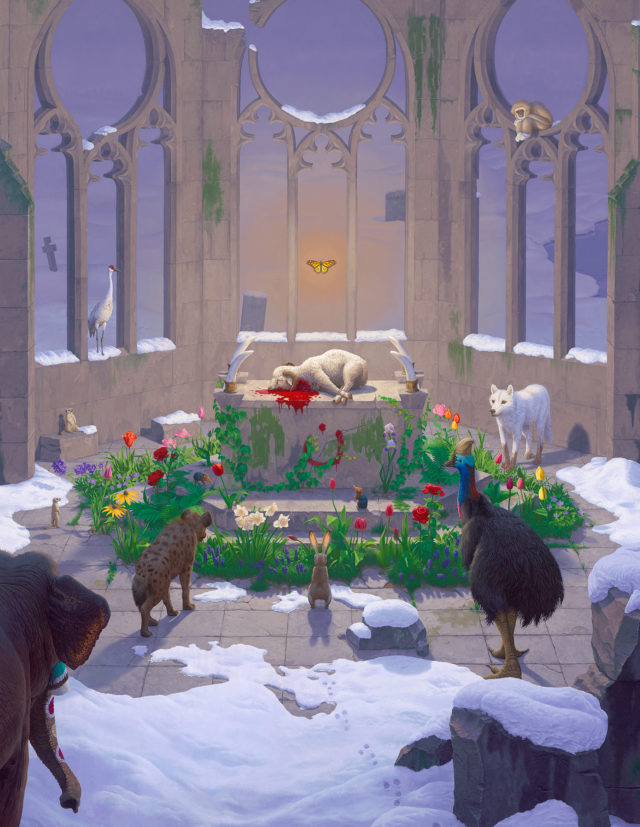
The choice to set the scene amidst the ruins of a Gothic cathedral was inspired by nineteenth-century Romantic painter Caspar David Friedrich, who depicted abandoned abbeys, churches, and cemeteries in the bleak winter snow. In our 21st century post-Christian age, we are witnessing the decline of the Church in the West due to biblical compromise. In countries where Christianity is the fastest growing religion, the increase in persecution and martyrdom is grievous, as well as the destruction of Christian sacred sites by extremist groups like ISIS. The abandoned ruins in my painting reflect the fractured state of our world, the wasteland we find ourselves in when we reject the Creator and his creation.
To me, Jesus’ way of servant leadership and self-sacrifice is the antidote for power and greed, which is the impetus behind environmental exploitation. However, that is only part of the Jesus phenomenon. We read further about the Suffering Servant described by Isaiah:
Surely he took up our pain
and bore our suffering,
yet we considered him punished by God,
stricken by him, and afflicted.
But he was pierced for our transgressions,
he was crushed for our iniquities;
the punishment that brought us peace was on him,
and by his wounds we are healed.
(Isaiah 53:4-5)
Jesus lived the perfect life that we could not. For all of the advancements in science and technology, humankind has still not found a solution for our individual bent to do what is wrong, or to heal our world of evil, or quell the curse of death. As with followers of Jesus Christ throughout the centuries, I believe Jesus’ life, death, and resurrection can bring about the ultimate healing we need. The biblical concept for describing Christ’s sacrifice on the cross is called “atonement.” This carries two components: a ‘covering’ to exonerate us for personal and systemic sin, which is a gift of grace that we do not deserve. And secondly, reconciliation, bringing us back into a right relationship with God. Hence, ‘at-one-ment’ with our Creator.
The effect of this reconciliation is also cosmic in scope. An often overlooked benefit of Christ’s atonement is that we can also be brought back into right relationship with creation, since it is through the Creator that the cosmos was created and will be restored (Colossians 1:15-20). The Judaic sacrificial system was in no way God’s ideal. In the Garden of Eden the first primal couple, Adam and Eve, were prohibited to take the life of any animal, nor were even the animals (Genesis 1:29-30). After Christ’s sacrifice no more animal sacrifices were required, and we look forward to the day that the world’s wastelands become like Eden once again (Isaiah 51:3). In contrast to the notion that we can ‘trash’ this world and escape to heaven, Scripture speaks to the future restoration of the earth and its animals, when heaven and earth become one (Leading biblical scholar N.T. Wright espouses this view in his book, Surprised by Hope).
Isaiah records the Creator’s promise:
See, I will create
new heavens and a new earth.
The former things will not be remembered
(Isaiah 65:17)
In my painting, the bleak winter backdrop is contrasted with the warmth emanating from the Monarch Butterfly, my symbol for the breath of life by the Spirit of God. The animals, flora and fauna are drawn to the light, from which new growth springs up. Many of the animals I chose are overlooked species like the Cassowary, and those demonized like the Spotted Hyena. The flowers and foliage are diverse — a beautifully wild garden of roses, irises, hyacinth, tulips, ferns, ivy, moss, and more. Out of death new life is born. This concept was inspired by Isaiah’s poems:
The desert and the parched land will be glad;
the wilderness will rejoice and blossom.
Like the crocus, it will burst into bloom;
it will rejoice greatly and shout for joy…
they will see the glory of the Lord,
the splendour of our God.
(Isaiah 35:1-2)
The appearance of animals and plants from all over the earth coming to the Lamb, signifies a new earth that defies normal boundaries and natural laws, as even towering cedars will appear in the desert (Isaiah 41:19). Isaiah foresaw a future peaceable kingdom without animal predation, where “the wolf will live with the lamb” (Isaiah 11:6). This theme is echoed in the final book of the Bible, where all the creatures on earth and in the sea will encircle the throne, praising the Lamb who was slain (Revelation 5:11-13). I believe that the loss of entire ecosystems will be put right by the Creator, bringing justice to these species and enabling them to experience earthly life again. The Apostle Paul states that the “whole creation has been groaning,” and that it “eagerly looks forward to being liberated from its bondage to decay and brought into the freedom and glory of the children of God” (Romans 8:21-22).
In the meantime, we must recognize that “the land mourns and wastes away” (Isaiah 33:7) as a result of the curse from humanity’s sin (Genesis 3:16-18). This is witnessed in the horrors of deforestation, oil spills, and rapid species extinction. Whether you believe in God or not, we can all be involved in rectifying the harm humans have done to nature in the past and in the present, thereby foreshadowing a better future. Unlike some environmentalists, I participate in caring for creation from a place of grace, not legalism. I also recognize that the problem isn’t only external — governments and corporations (although they are culpable too), but in my own heart. With our best human efforts global environmental sustainability is possible, but the world will still be broken in other ways because our deeper need is spiritual renewal. I rest in the abiding assurance that a broken world can only be restored by its Creator, and that’s where I personally find hope for the future.
Ultimately, my painting is a statement on how Christ’s substitutionary sacrificial death for the sins of humanity is “good news” (the gospel) for those who accept this gift of grace, but also good news for all of creation, even animals, since they will no longer suffer at the hands of humans in the new heavens and new earth. For the present we are called to “see in the face of the Crucified the faces of all innocent, suffering creatures,” living out our reconciliation to creation (Andrew Linzey, Animal Gospel, 7).

Streams in the Wasteland Book Summary
Streams in the Wasteland is a dynamic body of work completed by artist Josh Tiessen over the course of six years. In the style of Narrative Hyper-Surrealism these exquisitely crafted oil paintings depict nature’s reclamation. In them, wild animals have dominion over human civilizations, implicating humankind for ignoring the Creator’s call to care for the earth. The artist’s desire is to offer streams of hope within the apocalyptic wasteland. Exhibited across multiple gallery shows, for the first time the entire Streams in the Wasteland series is presented in a luxurious hardcover monograph book. Tiessen’s articulate synopsis explains the series, with informative commentary and humourous anecdotes accompanying each of the full-colour images, reflecting on the environmental and spiritual themes behind his work. While viewing the art, enjoy listening to the Streams in the Wasteland (Original Soundtrack), composed by musician Zac Tiessen, soon to be available on CD, Spotify, and Apple Music.
You can pre-order or purchase Streams in the Wasteland on his website.
"*" indicates required fields

